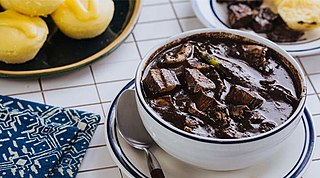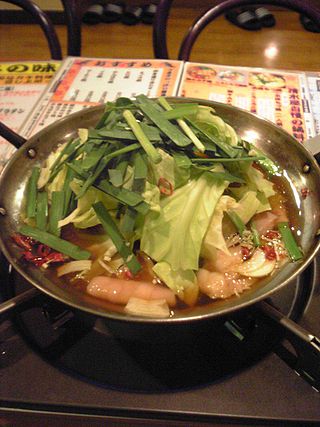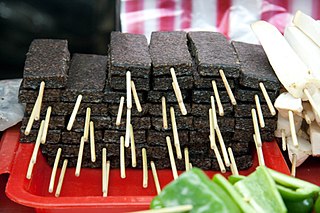
Thai cuisine is the national cuisine of Thailand.

Offal, also called variety meats, pluck or organ meats, is the internal organs of a butchered animal. The word does not refer to a particular list of edible organs, and these lists of organs vary with culture and region, but usually exclude skeletal muscle. Offal may also refer to the by-products of milled grains, such as corn or wheat.

Peasant foods are dishes eaten by peasants, made from accessible and inexpensive ingredients.

Cellophane noodles, or fensi, sometimes called glass noodles, are a type of transparent noodle made from starch and water. A stabilizer such as chitosan may also be used.

Kuyteav is a Cambodian noodle soup consisting of rice noodles with pork stock and toppings. Originating from Chinese Cambodian cuisine, it is now a popular breakfast dish across all of Cambodia. The kuyteav can be found at marketplace stalls, roadside vendors, restaurants and in shophouses across the country, and is distinguished by its clear broth and array of herbs, aromatics and other garnishes and condiments. A related dish is the Vietnamese Hủ tiếu, which was introduced to Vietnam by Chinese Cambodian immigrants in the 1970s.

Pancit, also spelled pansít, is a general term referring to various traditional noodle dishes in Filipino cuisine. There are numerous types of pancit, often named based on the noodles used, method of cooking, place of origin, equal and constant diameter or the ingredients. Most pancit dishes are characteristically served with calamansi, which adds a citrusy flavor profile.

Noodle soup refers to a variety of soups with noodles and other ingredients served in a light broth. Noodle soup is a common dish across East Asia, Southeast Asia and the Himalayan states of South Asia. Various types of noodles are used, such as rice noodles, wheat noodles and egg noodles.

Rice noodles are noodles made with rice flour and water as the principal ingredients. Sometimes ingredients such as tapioca or corn starch are added in order to improve the transparency or increase the gelatinous and chewy texture of the noodles. Rice noodles are most common in the cuisines of China, India and Southeast Asia. They are available fresh, frozen, or dried, in various shapes, thicknesses and textures. Fresh noodles are also highly perishable; their shelf life may be just several days.

Dinuguan is a Filipino savory stew usually of pork offal and/or meat simmered in a rich, spicy dark gravy of pig blood, garlic, chili, and vinegar.

Motsunabe (もつ鍋) is a type of nabemono in Japanese cuisine, which is made from beef or pork tripe or other offal. It is a popular stew made with guts portions of various types of meat, prepared in a conventional kitchen cooking pot or a special Japanese nabe pot (nabe). When it is cooked, it is filled with soup, prepared beef or pork offal and boiled for a while; cabbage and garlic chives are added. The base soup is usually soy sauce with garlic and chili pepper, or miso. Champon noodles are often put into the pot and boiled to complete the dish. The offal used in motsunabe is mostly beef intestines, but various kinds of offal can be used.

Batchoy, alternatively spelled batsoy, is a Filipino noodle soup of pork offal, crushed pork cracklings, chicken stock, beef loin, and round noodles. The original and most popular variant, the La Paz batchoy, traces its roots to the Iloilo City district of La Paz, in the Philippines.

Blood soup is any soup that uses blood as a principal ingredient.

Blood as food is the usage of blood in food, religiously and culturally. Many cultures consume blood, often in combination with meat. The blood may be in the form of blood sausage, as a thickener for sauces, a cured salted form for times of food scarcity, or in a blood soup. This is a product from domesticated animals, obtained at a place and time where the blood can run into a container and be swiftly consumed or processed. In many cultures, the animal is slaughtered. In some cultures, blood is a taboo food.

Prawn soup, also referred to as shrimp soup, is a soup dish prepared using freshwater or saltwater prawns as a primary ingredient. Several varieties of the dish exist in various areas of the world, including Penang prawn mee in Malaysia, Peruvian chupe de camarones, Thai kaeng som kung and Mexican caldo de camarones. Prawn and shrimp soup can be prepared as a broth- or stock-based soup, as a cream-based soup, or as a chowder. In the United States, cream of shrimp soup is mass-produced and distributed canned or frozen.

Nam ngiao or nam ngio is a noodle soup or curry of the cuisine of the Tai Yai people who live in the northeast of Burma, the southwest of Yunnan province, China, and in northern Thailand, mainly in Mae Hong Son Province. The dish has become famous through the northern Thai cuisine. Nam ngiao has a characteristic spicy and tangy flavor.

Hot and sour soup is a popular example of Chinese cuisine. Although it is said to be originated in Sichuan, this is actually a variant of hulatang or "pepper hot soup" (胡辣汤) with added vinegar to enhance the sourness. This variation is found in Henan province, and in Henan cuisine itself. Also popular in Southeast Asia, India, Pakistan and the United States, it is a flexible soup which allows ingredients to be substituted or added depending on availability. For example, the American-Chinese version can be thicker as it commonly includes corn starch, whilst in Japan, sake is often added.

Sabahan cuisine is a regional cuisine of Malaysia. As in the rest of Malaysian cuisine, Sabah food is based on staples such as rice with a great variety of other ingredients and different methods of food preparations due to the influence of the state's varied geography and indigenous cultures that were quite distinct from the regional cuisines of the Peninsular Malaysia. Sabah along with its neighbour of Sarawak is famous for their multi-ethnic population.

Kway jap, also spelt kuay jap is a Teochew noodle soup originating in Chinese cuisine consisting of flat, broad rice sheets (kway) in a soup made with dark soy sauce, served with an assortment of pork cuts including offal, pork belly, intestines, and pig's ears, braised duck meat, various kinds of beancurd, preserved salted vegetables, and braised hard-boiled eggs.

Batchoy Tagalog, also known simply as batsoy, is a traditional Filipino food originating in the northern Philippines. This soup is made with pork, pork offal, pork blood, noodles, chili leaves or garlic chives, green chilies, garlic, onions, and ginger. It is also referred to as sutsa or syutsa in the province of Quezon and sinuam in Angono, Rizal. This dish is usually paired with or eaten with cooked rice as a viand.



















